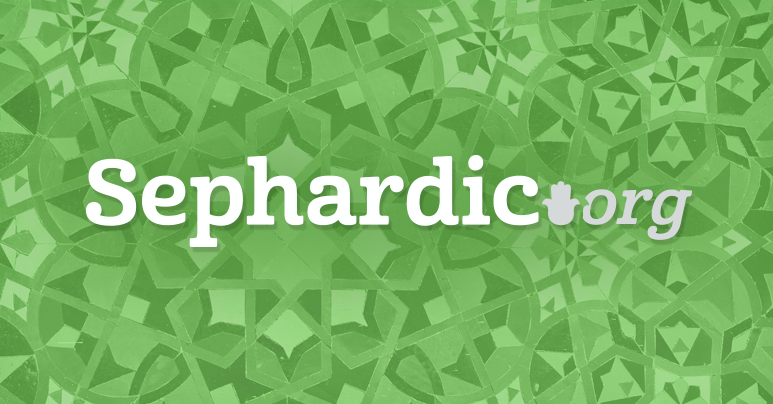
SHELAH - TALIT - GARMENT OF THE PAST PRESENT AND FUTURE
The Sages call the four cornered garment with Sisit attached a Talit. A word denoting something superior. Though the commandment to affix Sisit onto the corners of one's garment prior to wearing it appears towards the conclusion of our Parasha - we do know of earlier references to this special garment. We are told in the Talmud that God appeared in a vision before Moshe as a Shaliah Sibbour enwrapped in a Talit reciting the 13 attributes. 1 Our Sages associate it with Adam's clothing in Gan Eden as well as with the conflict between Kayin and Hevel. Surely all this to impress upon us that it is historically intertwined with us as a people. Furthermore the injunction to affix Sisit includes the promise or hope that via this Misva we attain sanctity. In addition we will attempt to elaborate on how we are to mimic the Hayyot - or angelic beings above by enwrapping ourselves with this holy garment. Finally we will see that the Sages associate the Talit with the future era of enlightenment. In fact R. Bahya asserts that the Talit serves as a reminder that in the future God will resurrect the dead and dress them in garments appropriate for their elevated state. 2
GARMENT OF THE PAST
According to its historical origin the relationship of clothing to our human calling is an intimate one. The Talit in particular is said to protect one from going astray. R. Yoseph Hayyim in his Sefer Ben Ish Hai writes that Adam was created with a celestial garb with אור מקיף - surrounding light. The נחש was ערום or naked of this precious light which he desired. Lacking the wherewithal to nourish from Adam's holiness the נחש intended to cause him to sin in order to disrobe him of this garb of light. The Talitot that we don are a throw back to these original garments of light as it also exhibits the אור מקיף or surrounding lights. 3 Furthermore, sources including Pirqe DiRibbi Eliezer and Midrash Tanhuma attempt to relate the conflict between Kayin and Hevel and the prohibition of Shaatnez with the the Misva of Sisit. While Hevel's sacrifice consisted of wool, that of Kayin was of linen. The Lord said it is incorrect that the offering of the guilty be mixed with that of the innocent. 4 An exception to the rule of mixing these fabrics for an Israelite is cited in Yevamot where under certain conditions a Talit with Sisit that contains Tekhelet can contain permissible Shaatnez. 5 Evidently the symbol of severance (Shaatnez) that existed between the brothers can be neutralized. This is clearly due to the fact that Tekhelet is to remind one of the Kise HaKavod. 6 In the celestial region of the throne there is no tension between the brothers and no fear in arousing severance. A similar idea to what we find in the Talmud when Hashem advises Moshe to grab onto the Divine throne above for protection from the harming Angels. 7
GARMENT OF THE PRESENT
With the creation of man, God intended for him to fulfill a role on earth which the Hayyot perform above. That is to support the Divine Throne in the celestial regions. According to the vision of Yehezkel each of the Hayyot had four wings. 8 We likewise drape a Talit around ourselves likewise containing four wings. Both the verses in Bemidbar and Devarim that discuss the Misva borrow the term wings כנפות - instead of קרנות or corners. 9 This is to remind us that we are Holy Beings - carriers of the מרכבה - when garbed in our Holy uniforms. The Hinukh cites the Pirke DeRibbi Eliezer - "From what was the earth created? From the snow that is beneath the throne of glory (this relates to the white threads). They saw the God of Israel, there was under his feet a pavement of sapphire stone - (this relates to the blue thread of Tekheket). As the appearance of a sapphire stone, there was a likeness of a throne. 10 The Hinukh adds that beneath the throne of glory is the place we - the spirits of the righteous remain hidden. This can parallel our existence below - as we wrap ourselves in the Talit with the holy white and blue tassels as the snow and sapphire above. The Sages of the Talmud taught that the windings (the techelet string around the white) should not be fewer than seven or more than thirteen. All of this to allude to the celestial worlds above that contain seven firmaments and the six spaces between them. 11 Four wings each lay at one of the four directions paralleling the four carriers of the throne. According to the school of Hillel only three strings are required on each wing, likely paralleling the three tribes that are fixed on each of the four sides around the Sanctuary. The halakha however accords with the school of Shammai who requires four strings 12 (Doubled over as 8) - likely associated with the holy 4 letter name YHVH pronounced ADNY.
GARMENT OF THE FUTURE
As a result of the sin of the spies a divine decree was given that the Jews of the wilderness between the ages of 20 and 60 will be forced to remain there and die. The Midrash teaches that they entered their graves annually and would pass away there. 13 The Talmud relates that Rabbah Bar Bar Hannah was shown these corpses and cut off a corner of one of their burial garments to present it in the study hall. He intended to bring this as archaeological proof to help determine the halakhic query between the scholars regarding the required amount of strings. The Rabbi however became immobilized - he was advised to return his find back to the grave. He later related the incident to his colleagues in the study hall who reprimanded him for not taking a mental note of what he saw on the corner of the garment. 14 Shulkhan Arukh records the custom to bury the deceased wrapped in a Talit. 15 Likely based on this Gemara as a garment reserved at tehiyat hametim. This relationship with the future can be seen from a derasha cited in Sefer Ben Ish Hai on a verse from Shemot related to the redemption. ואשא אתכם על כנפי נשרים - I will raise you via the wings of nesharim - 16 the numerical value of which is 600 which parallels that of ציצית -Furthermore - The wings or corners upon which the tassels are tied should have its upper third wound and the lower two thirds hanging freely. 17 R. Bahya cites a verse from Sefer Devarim that compares this divide with our relationship with the nations. “He will make you highest of all the nations!” A convincing detailed proof of this divide is cited from Zekharya "Throughout the land...2/3 shall perish and 1/3 shall survive.” Based on this verse he cites a Midrash that the 1/3 survivors are the Jews. How do we know ? There is another corroborating verse in Sefer Yishaya - In that day (future), Israel shall be a third, as a blessing on earth. 18 This relationship of the Talit with the future period of enlightenment is noted in the Talmud 19 - Anyone who observes the Misva of Sisit will merit to be attended by 2800 servants. This is based on the verse in Zekharya - “In those days (future) ten men from nations (70) of every tongue (total 700) - will take hold of every Jew by the corner (4) of his cloak (total 2800) and say "Let us go with you, for we have heard that God is with you."
SUMMARY
We have seen that the Talit or at least it's spiritual properties were given to Adam in Gan Eden. Though he was disrobed - we his descendants are given the opportunity to clothe ourselves in this spiritually potent garment. It represents our task on earth to be the carriers of the Divine Throne. In the future it will be recognized as the uniform of the people of Israel. The nations will recognize what the garb represents. They will be moved with a desire to attach themselves to the spiritual by holding onto the wings of our Talitot. They will say "Let us go with you, for we have heard that God is with you."
Shabbat Shalom








